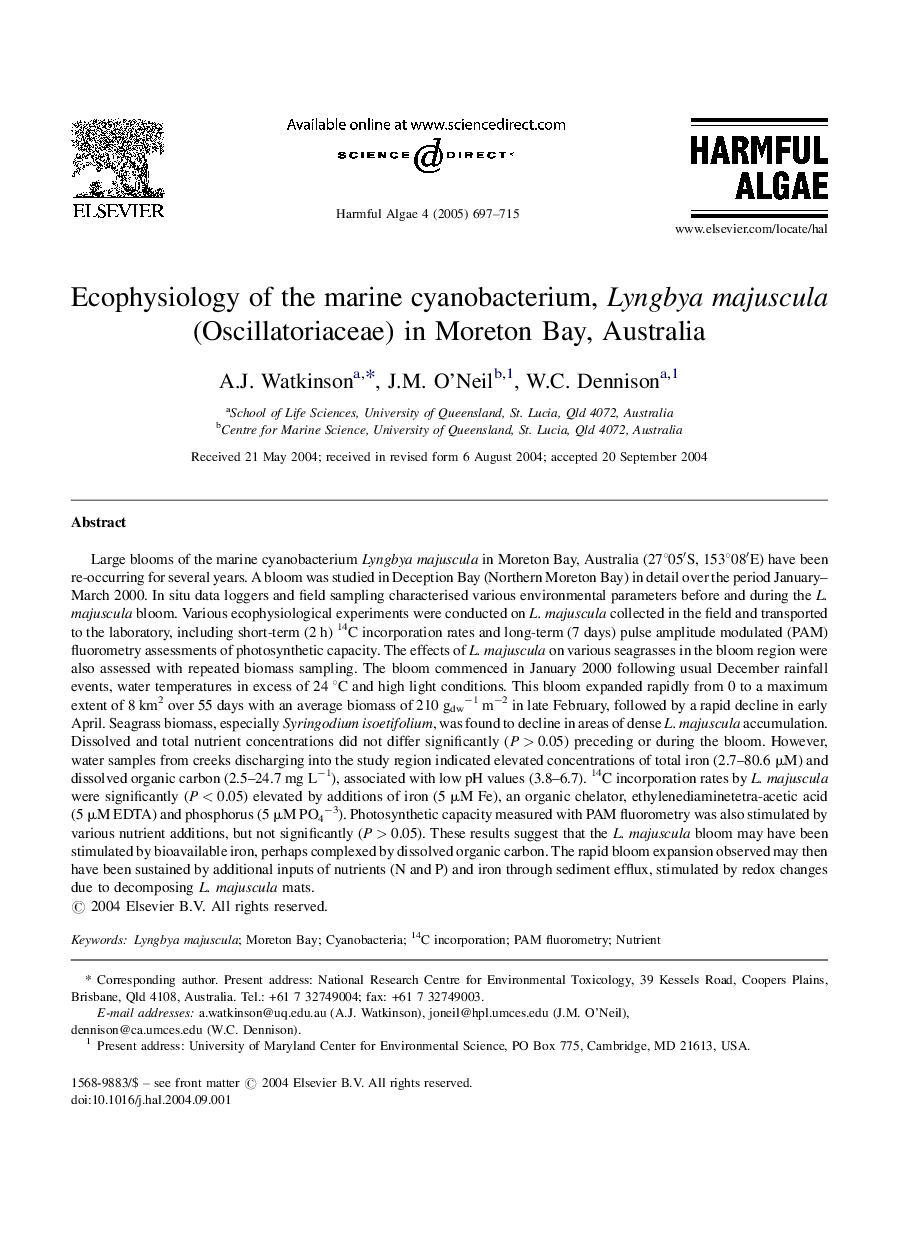| کد مقاله | کد نشریه | سال انتشار | مقاله انگلیسی | نسخه تمام متن |
|---|---|---|---|---|
| 9482607 | 1327502 | 2005 | 19 صفحه PDF | دانلود رایگان |
عنوان انگلیسی مقاله ISI
Ecophysiology of the marine cyanobacterium, Lyngbya majuscula (Oscillatoriaceae) in Moreton Bay, Australia
دانلود مقاله + سفارش ترجمه
دانلود مقاله ISI انگلیسی
رایگان برای ایرانیان
کلمات کلیدی
موضوعات مرتبط
علوم زیستی و بیوفناوری
علوم کشاورزی و بیولوژیک
علوم آبزیان
پیش نمایش صفحه اول مقاله

چکیده انگلیسی
Large blooms of the marine cyanobacterium Lyngbya majuscula in Moreton Bay, Australia (27°05â²S, 153°08â²E) have been re-occurring for several years. A bloom was studied in Deception Bay (Northern Moreton Bay) in detail over the period January-March 2000. In situ data loggers and field sampling characterised various environmental parameters before and during the L. majuscula bloom. Various ecophysiological experiments were conducted on L. majuscula collected in the field and transported to the laboratory, including short-term (2 h) 14C incorporation rates and long-term (7 days) pulse amplitude modulated (PAM) fluorometry assessments of photosynthetic capacity. The effects of L. majuscula on various seagrasses in the bloom region were also assessed with repeated biomass sampling. The bloom commenced in January 2000 following usual December rainfall events, water temperatures in excess of 24 °C and high light conditions. This bloom expanded rapidly from 0 to a maximum extent of 8 km2 over 55 days with an average biomass of 210 gdwâ1 mâ2 in late February, followed by a rapid decline in early April. Seagrass biomass, especially Syringodium isoetifolium, was found to decline in areas of dense L. majuscula accumulation. Dissolved and total nutrient concentrations did not differ significantly (P > 0.05) preceding or during the bloom. However, water samples from creeks discharging into the study region indicated elevated concentrations of total iron (2.7-80.6 μM) and dissolved organic carbon (2.5-24.7 mg Lâ1), associated with low pH values (3.8-6.7). 14C incorporation rates by L. majuscula were significantly (P < 0.05) elevated by additions of iron (5 μM Fe), an organic chelator, ethylenediaminetetra-acetic acid (5 μM EDTA) and phosphorus (5 μM PO4â3). Photosynthetic capacity measured with PAM fluorometry was also stimulated by various nutrient additions, but not significantly (P > 0.05). These results suggest that the L. majuscula bloom may have been stimulated by bioavailable iron, perhaps complexed by dissolved organic carbon. The rapid bloom expansion observed may then have been sustained by additional inputs of nutrients (N and P) and iron through sediment efflux, stimulated by redox changes due to decomposing L. majuscula mats.
ناشر
Database: Elsevier - ScienceDirect (ساینس دایرکت)
Journal: Harmful Algae - Volume 4, Issue 4, June 2005, Pages 697-715
Journal: Harmful Algae - Volume 4, Issue 4, June 2005, Pages 697-715
نویسندگان
A.J. Watkinson, J.M. O'Neil, W.C. Dennison,